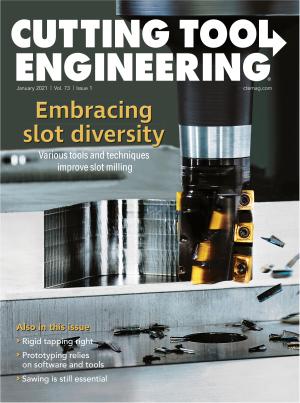The cutting tool industry is what some may call a dinosaur. But while it’s true that much of the industry is driven by a demographic and a generational culture that might be described as old-school, I think it’s more accurate to say that ours is a 20th-century business competing in the 21st century.
What does that mean? I think that the traditional focus has been on selling the tools themselves but not so much on the technology and innovation behind them or on the services that now can be provided in support of them. We need to emphasize the technical, more complex aspects of our work. We should get the first pass at that work, which otherwise might be offshored as a standard proactive in current business models of companies. With our customer base becoming broader and demanding a higher level of quality, consistency and service, we need to evolve and become more driven by engineering services.
Several factors are changing things, however. Certainly, how the business of our customers is shifting has an impact. They’re competing — selling products — in an environment that demands more innovation and technology and faster turnaround time, all at a lower cost. And of course, all this is needed without sacrificing quality and while meeting whatever regulatory standards may apply to products and industries. Those are a few critical aspects that drive the need for the cutting tool industry to evolve, but we’re living through what might be one of the biggest causes.

COVID-19 radically changed how we do business. We have had to rethink how we manufacture. We’ve had to reinvent our marketing and sales strategies. We’re learning new ways to nurture relationships with customers and partners.
The concept of sales has changed. Decades ago, sales representatives in our industry worked from cars and hotel rooms, carried briefcases full of collateral, lugged product sample cases and, while on the road, kept in touch with the office and customers by pay phone.
Even when we began to turn the corner 15 or 20 years ago and started using mobile phones and laptops, compared with other industries like software, technology and aerospace, our industry was still a decade behind regarding how we did business. Even now, utilizing real-time video meetings to deal with the limitations of the pandemic, using social media programs to engage customers and leveraging digital technology for orders and services, we remain a decade behind.
We still trail industries outside the manufacturing industry vertical in the full implementation of e-marketing, digital encounters and all the technology channels available today to drive sales, enhance customer experiences and nurture customer relationships. In many ways, we’re stuck in that old-school, 20th-century thought process.
Consider our experience working through COVID-19. Suddenly, our workforce couldn’t mobilize, and our sales force couldn’t meet customers. We lost face-to-face personal interaction, which meant a pivot from the traditional selling strategy. When you can’t look a customer in the eye, shake his or her hand and say, “This is who we are, this is our value, and this is what we can do for you,” you need to find other ways to deliver that message and manage the relationship.
One interesting thing is that our customers are working under the same limitations during all this, so there is a real opportunity to look for unconventional solutions. Additionally, we’re experiencing sort of a contraction of the industry. This is partly because of the pandemic, but I think that other factors are driving it, including the economy.
Through all this, we’ve demonstrated we can drive the sales process and marketing process in a very cost-effective manner. In sales, we immediately focused on necessary education. We trained our sales team on the latest digital tools, not only in reaction to the crisis but proactively so personnel would be prepared for the sales environment of the future. On the marketing side, we took the significant step of launching our Centralized Distribution Center. The CDC provides quick, convenient access to the best general machining and high-performance cutting tools on the market when customers need them. Customers appreciate this because they’ve felt the pressure and constraints of the pandemic too. This forward-looking approach helps them do business during a trying time. Progressive, innovative initiatives like these position us to evolve internally, establishing new methods and processes to ensure our market success.



